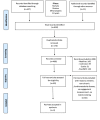Improving Engagement Among Patients With Chronic Cardiometabolic Conditions Using mHealth: Critical Review of Reviews
- PMID: 32267239
- PMCID: PMC7177429
- DOI: 10.2196/15446
Improving Engagement Among Patients With Chronic Cardiometabolic Conditions Using mHealth: Critical Review of Reviews
Abstract
Background: The burden imposed by cardiometabolic diseases remains a principal health care system concern. Integration of mobile health (mHealth) interventions is helpful for telemonitoring of these patients, which enables patients to be more active and take part in their treatment, while being more conscious and gaining more control over the outcomes. However, little is known about the degree to which users engage, and the extent to which this interaction matches the usage pattern for which mHealth interventions were designed.
Objective: The aim of this study was to describe the characteristics and results of studies on mHealth solutions that measured the effects of interventions with patient engagement in the context of chronic cardiometabolic diseases.
Methods: A critical review of systematic reviews was conducted to recover data on interventions focused on the engagement of patients with chronic cardiometabolic diseases using mHealth technologies. Articles (from January 1, 2010) were searched in the Medlars Online International Literature Medline (Medline/Pubmed), Embase, Cochrane Library, PsycINFO, and Scielo databases. Only studies that quantified a measure of engagement by patients with cardiometabolic disease were included for analysis. The Critical Appraisal Skills Programme (CASP) was used to determine included studies considering the quality of the data provided. The Scottish Intercollegiate Guidelines Network (SIGN) checklist was used to assess the quality of the evidence according to the methodology used in the studies reviewed. Engagement was defined as the level of patient implication or participation in self-care interventions. Engagement measures included number of logs to the website or platform, frequency of usage, number of messages exchanged, and number of tasks completed.
Results: Initially, 638 papers were retrieved after applying the inclusion and exclusion criteria. Finally, only three systematic reviews measuring engagement were included in the analysis. No reviews applying a meta-analysis approach were found. The three review articles described the results of 10 clinical trials and feasibility studies that quantified engagement and met the inclusion criteria assessed through CASP. The sample size varied between 6 and 270 individuals, who were predominantly men. Cardiac disease was the principal target in the comparison of traditional and mHealth interventions for engagement improvement. The level of patient engagement with mHealth technologies varied between 50% and 97%, and technologies incorporating smartphones with a reminder function resulted in the highest level of engagement.
Conclusions: mHealth interventions are an effective solution for improving engagement of patients with chronic cardiometabolic diseases. However, there is a need for advanced analysis and higher-quality studies focused on long-term engagement with specific interventions. The use of smartphones with a single app that includes a reminder function appears to result in better improvement in active participation, leading to higher engagement among patients with cardiometabolic diseases.
Keywords: cardiovascular disease; chronic disease; diabetes; engagement; mHealth; obesity; patients; telemedicine.
©Kamila J Cheikh-Moussa, Jose Joaquin Mira, Domingo Orozco-Beltran. Originally published in JMIR mHealth and uHealth (http://mhealth.jmir.org), 08.04.2020.
Conflict of interest statement
Conflicts of Interest: None declared.
Figures
References
-
- WHO Global Observatory for eHealth . World Health Organization. Switzerland: World Health Organization; 2011. [2019-02-18]. mHealth: new horizons for health through mobile technologies: second global survey on eHealth https://apps.who.int/iris/handle/10665/44607.
-
- World Health Organization . World Health Organization. Geneva, Switzerland: World Health Organization; 2010. [2019-02-19]. Global status report on noncommunicable diseases 2010 https://www.who.int/nmh/publications/ncd_report2010/en/
-
- Risling T, Martinez J, Young J, Thorp-Froslie N. Evaluating Patient Empowerment in Association With eHealth Technology: Scoping Review. J Med Internet Res. 2017 Sep 29;19(9):e329. doi: 10.2196/jmir.7809. https://www.jmir.org/2017/9/e329/ - DOI - PMC - PubMed
-
- Mathers CD, Loncar D. Projections of global mortality and burden of disease from 2002 to 2030. PLoS Med. 2006 Nov 28;3(11):e442. doi: 10.1371/journal.pmed.0030442. http://dx.plos.org/10.1371/journal.pmed.0030442 - DOI - DOI - PMC - PubMed
Publication types
MeSH terms
LinkOut - more resources
Full Text Sources
Medical
Miscellaneous


